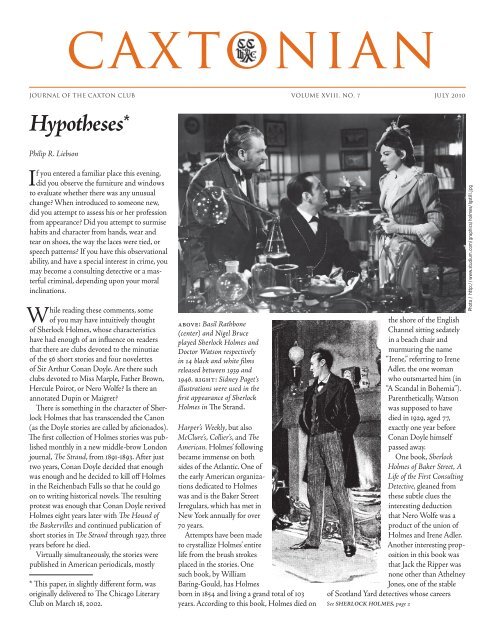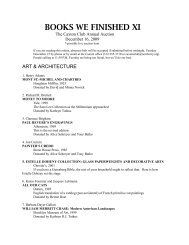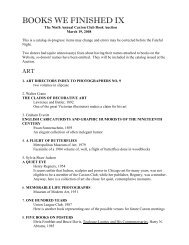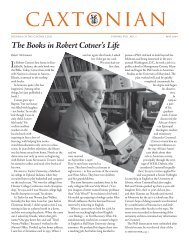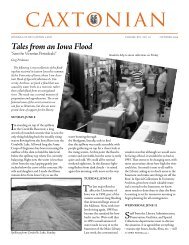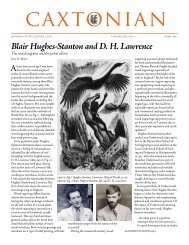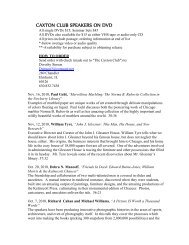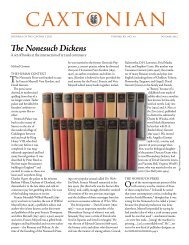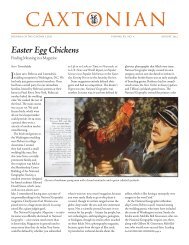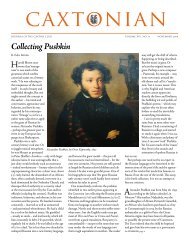July - The Caxton Club
July - The Caxton Club
July - The Caxton Club
You also want an ePaper? Increase the reach of your titles
YUMPU automatically turns print PDFs into web optimized ePapers that Google loves.
caxtonian<br />
JOURNAL OF THE CAXTON CLUB VOLUME XVIII, NO. 7 JULY 2010<br />
Hypotheses*<br />
Philip R. Liebson<br />
If you entered a familiar place this evening,<br />
did you observe the furniture and windows<br />
to evaluate whether there was any unusual<br />
change When introduced to someone new,<br />
did you attempt to assess his or her profession<br />
from appearance Did you attempt to surmise<br />
habits and character from hands, wear and<br />
tear on shoes, the way the laces were tied, or<br />
speech patterns If you have this observational<br />
ability, and have a special interest in crime, you<br />
may become a consulting detective or a masterful<br />
criminal, depending upon your moral<br />
inclinations.<br />
While reading these comments, some<br />
of you may have intuitively thought<br />
of Sherlock Holmes, whose characteristics<br />
have had enough of an influence on readers<br />
that there are clubs devoted to the minutiae<br />
of the 56 short stories and four novelettes<br />
of Sir Arthur Conan Doyle. Are there such<br />
clubs devoted to Miss Marple, Father Brown,<br />
Hercule Poirot, or Nero Wolfe Is there an<br />
annotated Dupin or Maigret<br />
<strong>The</strong>re is something in the character of Sherlock<br />
Holmes that has transcended the Canon<br />
(as the Doyle stories are called by aficionados).<br />
<strong>The</strong> first collection of Holmes stories was published<br />
monthly in a new middle-brow London<br />
journal, <strong>The</strong> Strand, from 1891-1893. After just<br />
two years, Conan Doyle decided that enough<br />
was enough and he decided to kill off Holmes<br />
in the Reichenbach Falls so that he could go<br />
on to writing historical novels. <strong>The</strong> resulting<br />
protest was enough that Conan Doyle revived<br />
Holmes eight years later with <strong>The</strong> Hound of<br />
the Baskervilles and continued publication of<br />
short stories in <strong>The</strong> Strand through 1927, three<br />
years before he died.<br />
Virtually simultaneously, the stories were<br />
published in American periodicals, mostly<br />
* This paper, in slightly different form, was<br />
originally delivered to <strong>The</strong> Chicago Literary<br />
<strong>Club</strong> on March 18, 2002.<br />
above: Basil Rathbone<br />
(center) and Nigel Bruce<br />
played Sherlock Holmes and<br />
Doctor Watson respectively<br />
in 14 black and white films<br />
released between 1939 and<br />
1946. right: Sidney Paget’s<br />
illustrations were used in the<br />
first appearance of Sherlock<br />
Holmes in <strong>The</strong> Strand.<br />
Harper’s Weekly, but also<br />
McClure’s, Collier’s, and <strong>The</strong><br />
American. Holmes’ following<br />
became immense on both<br />
sides of the Atlantic. One of<br />
the early American organizations<br />
dedicated to Holmes<br />
was and is the Baker Street<br />
Irregulars, which has met in<br />
New York annually for over<br />
70 years.<br />
Attempts have been made<br />
to crystallize Holmes’ entire<br />
life from the brush strokes<br />
placed in the stories. One<br />
such book, by William<br />
Baring-Gould, has Holmes<br />
born in 1854 and living a grand total of 103<br />
years. According to this book, Holmes died on<br />
the shore of the English<br />
Channel sitting sedately<br />
in a beach chair and<br />
murmuring the name<br />
“Irene,” referring to Irene<br />
Adler, the one woman<br />
who outsmarted him (in<br />
“A Scandal in Bohemia”).<br />
Parenthetically, Watson<br />
was supposed to have<br />
died in 1929, aged 77,<br />
exactly one year before<br />
Conan Doyle himself<br />
passed away.<br />
One book, Sherlock<br />
Holmes of Baker Street, A<br />
Life of the First Consulting<br />
Detective, gleaned from<br />
these subtle clues the<br />
interesting deduction<br />
that Nero Wolfe was a<br />
product of the union of<br />
Holmes and Irene Adler.<br />
Another interesting proposition<br />
in this book was<br />
that Jack the Ripper was<br />
none other than Athelney<br />
Jones, one of the stable<br />
of Scotland Yard detectives whose careers<br />
See SHERLOCK HOLMES, page 2<br />
Photo / http://www.studium.com/graphics/holmes/lgstill.jpg
oC A X T O N I A N<br />
<strong>Caxton</strong> <strong>Club</strong>, Founded 1895<br />
David S. Mann, President<br />
Wendy Cowles Husser, Vice-President<br />
Bruce H. Boyer, Secretary<br />
Thomas E. Swanstrom, Treasurer<br />
C. Steven Tomashefsky, Past<br />
President<br />
Council<br />
Class of 2010<br />
Dorothy J. Anderson<br />
Don Chatham<br />
Mary Ann Johnson<br />
Philip R. Liebson<br />
J. William Locke<br />
Class of 2011<br />
Martha Chiplis<br />
Jill Gage<br />
Bradley Jonas<br />
Dan “Skip” Landt<br />
Alice D. Schreyer<br />
Class of 2012<br />
Susan Hanes<br />
Jon Lellenberg<br />
Margaret Oellrich<br />
Morrell McKenzie Shoemaker, Jr.<br />
Mary S. Williams<br />
Appointed Officers<br />
Robert Karrow, Programs<br />
Paul F. Gehl, Archivist-Historian<br />
Hayward R. Blake, FABS<br />
Representative<br />
Committees<br />
Margaret Oellrich, Audio Visual<br />
J. William Locke, Dorothy Sinson<br />
(Co-Chairs), Friday Luncheons<br />
Dan “Skip” Landt, Membership<br />
Susan Rossen, Kim Coventry,<br />
Publications and Exhibitions<br />
Martha Chiplis, Scholarship<br />
John M. Dunlevy, Matthew Doherty,<br />
Web Site and Directory<br />
<strong>Caxton</strong> <strong>Club</strong> Staff<br />
Dan Crawford, General Manager<br />
<strong>Caxton</strong>ian<br />
Robert McCamant, Editor<br />
Brenda Rossini, Copy Editor<br />
Robert Cotner, Founder<br />
Matthew J.Doherty, Wendy Husser,<br />
Paul Ruxin, Florence Shay,<br />
Contributing Editors<br />
©2010, <strong>Caxton</strong> <strong>Club</strong>. <strong>The</strong> <strong>Caxton</strong>ian is published<br />
monthly by the <strong>Caxton</strong> <strong>Club</strong>, whose office is<br />
in <strong>The</strong> Newberry Library. Printing: Kelmscott<br />
Communications, Aurora, IL.<br />
SHERLOCK HOLMES, from page 1<br />
Holmes constantly advanced with his brilliant interventions.<br />
In <strong>The</strong> Sign of the Four: Holmes: “I am the<br />
last and highest court of appeal in detection. When<br />
Gregson or Lestrade or Athelney Jones are out of<br />
their depths (which, by the way, is their normal state)<br />
the matter is laid before me.”<br />
<strong>The</strong> identity of Jack the Ripper remains in doubt,<br />
but the play of fiction and fact always fascinates. In<br />
this case, Holmes deploys Jack the Ripper dressed<br />
as a woman, one of his many ingenious disguises.<br />
<strong>The</strong> conclusion is remarkable. Unlike any of the<br />
Holmes stories in the Canon, except one, Holmes is<br />
saved by Watson, who, at the last moment, as Jack is<br />
about to advance on the unconscious Holmes with a<br />
nine-inch knife in an isolated courtyard, leaps from<br />
a wall and smashes Jack’s head against the cobblestones,<br />
knocking him out. In this case, it is Watson<br />
who has deduced the identity of the Ripper, from<br />
evidence that Inspector Athelney Jones had at one<br />
time attended lectures in surgery, and could have<br />
been the only one of three candidates to have heard a<br />
previously murdered woman singing “Sweet Violets.”<br />
He shadowed the Inspector and was there to save<br />
Holmes. “Holmes took his pipe from his mouth,” as<br />
Watson described his own deductions. “Extraordinary,<br />
my dear Watson,” exclaimed Holmes. “Elementary,<br />
my dear Holmes,” replied Watson. For those of<br />
you Sherlockians who have not remembered the one<br />
story in the Canon in which Watson saved Holmes’<br />
life, by shoving him out of a room with poisonous<br />
fumes, it was “<strong>The</strong> Adventure of the Devil’s Foot.”<br />
This contribution notwithstanding, Watson is mistaken<br />
by some readers as a bumbler, though adroit<br />
athletically, and remarkably supportive of Holmes.<br />
Although he overlooks clues, he doesn’t get in the<br />
way of the progress of Holmes’ deductions.<br />
It is generally concluded by Sherlockians that<br />
Holmes was born on January 6, 1854. <strong>The</strong> evidence<br />
for the year is that Holmes is described as a man<br />
of 60 in His Last Bow, which takes place in 1914.<br />
<strong>The</strong> date of January 6th is speculative. Among<br />
the credible reasons are two: in <strong>The</strong> Valley of Fear,<br />
Holmes appears unusually grumpy on the morning<br />
of January 7th, suggestive of a hangover. Some<br />
scholars concluded that Holmes had celebrated his<br />
birthday the night before. Another reason, perhaps<br />
less credible, was that Holmes liked to quote from<br />
Twelfth Night, which is, of course, the 6th of January.<br />
However, Conan Doyle himself did not provide a<br />
clue. How could one rely on the author anyway <strong>The</strong><br />
Canon is filled with inconsistencies. <strong>The</strong> most notorious<br />
example is Watson’s war wound, suffered in<br />
Afghanistan from a Jezail bullet, which involved his<br />
shoulder in A Study in Scarlet, and his leg in <strong>The</strong> Sign<br />
of the Four. Given this example, there may be some<br />
question as to whether Holmes was really 60 in 1914.<br />
In science, a hypothesis is made after careful<br />
examination of observations. <strong>The</strong> purpose of the<br />
hypothesis is to test a possible connection, a cause<br />
and effect relationship that explains the workings of<br />
a small part of the universe. <strong>The</strong> more focused the<br />
hypothesis-testing, the more likely statistical evaluation<br />
will prove a result for or against the hypothesis.<br />
An interesting thing about scientific hypotheses<br />
is that the experiment to test the hypothesis also<br />
attempts to disprove what is called a null-hypothesis,<br />
which is that the results, if they are significant statistically,<br />
were not due to chance alone. (Even if this<br />
is determined to be so, there is always the possibility<br />
that a putatively proven hypothesis may be due to<br />
bias in setting up the experiment.)<br />
Doyle was writing in the 19th and early 20th<br />
centuries, before this form of statistical analysis was<br />
commonly used. But Holmes nonetheless predicted<br />
some of these considerations in his science of deduction.<br />
“We must fall back upon the old axiom that<br />
when other contingencies fail, whatever remains,<br />
however improbable, must be the truth.” [“<strong>The</strong><br />
Adventure of the Bruce-Partington Plans”] Here,<br />
indeed, is an expression of the null-hypothesis in<br />
Holmes’ terms.<br />
Much like a contemporary scientific researcher,<br />
Holmes begins with a series of related observations<br />
before he can develop a hypothesis. In “A Scandal in<br />
Bohemia,” he will not interpret without appropriate<br />
observation: “I have no data yet. It is a capital<br />
mistake to theorize before one has data. Insensibly<br />
one begins to twist facts to suit theories, instead of<br />
theories to suit facts.” This perfectly describes the<br />
problem of bias in scientific evaluation.<br />
Unlike the scientist, who tests observations by<br />
performing controlled studies to determine<br />
whether one intervention produces a desired result,<br />
Holmes analyzes meaning after collecting all the<br />
information possible. In <strong>The</strong> Hound of the Baskervilles,<br />
as an example, Holmes studies the dead corpse<br />
of Sir Charles Baskerville. A problem is stated: How<br />
did Sir Charles die A hypothesis is developed. <strong>The</strong><br />
man either died of a heart attack or by a dog. <strong>The</strong><br />
research process requires Watson to spend time<br />
openly in the Baskerville home, keeping a diary,<br />
while Holmes himself, as we discover later, secretly<br />
spends time in a secluded cave on the moor and<br />
visits the nearby village, collecting data. Holmes concludes<br />
from his analysis that only Stapleton could<br />
have been the killer for the plausible reason that he<br />
wanted the family wealth for himself. However, he<br />
has to test this hypothesis by a final and dangerous<br />
experiment, set up so that Stapleton is provoked to<br />
release his hound to attack the younger Baskerville.<br />
Such experiments are common in the field of detective<br />
literature, whereas scientific investigation involving<br />
humans is usually bolstered with safeguards.<br />
This is not always the case. I was involved in a<br />
<strong>The</strong> <strong>Caxton</strong> <strong>Club</strong> • 60 W. Walton St., Chicago, IL 60610-3305 • ph 312-255-3710 • caxtonclub@newberry.org • www.caxtonclub.org
large-scale study where the results indicated<br />
that, surprisingly, drugs used to save<br />
lives were associated with a higher mortality<br />
than a placebo. In scientific investigation,<br />
plausibility is important in testing<br />
hypotheses, but plausibility depends upon<br />
a rational view of the universe. If you<br />
believe in witchcraft and the supernatural,<br />
plausibility expands immensely. Plausibility<br />
is a weak link in the chain of hypothesis<br />
testing, along with bias in collecting<br />
data. In terms of my experience, from the<br />
same study, it was biologically plausible<br />
that a drug that decreased abnormal heart<br />
rhythms in people with underlying heart<br />
disease would save lives. In fact, it was<br />
more dangerous.<br />
Sherlock Holmes’ method of collecting<br />
A Paget illustration used<br />
start our speculation.”<br />
As for the oblique uses of knowledge,<br />
Holmes built compendia on<br />
arcane subjects. He was an expert<br />
on tobacco ashes, poisons, the<br />
characteristics of special soils, the<br />
appearance of hands with respect<br />
to the trade of their bearers, and<br />
writings. In “<strong>The</strong> Adventure of the<br />
Reigate Squire,” for example, he<br />
analyzes a written communication<br />
of several sentences, concluding that<br />
each word was written alternatively<br />
by a younger and an older man,<br />
probably blood relations, father<br />
and son. He concludes the different<br />
ages by the strong hand of half<br />
the words, and the “broken backed”<br />
information frequently mystifies in the first appearance of<br />
appearance of the other half, with<br />
Scotland Yard inspectors calling for his “A Scandal in Bohemia.”<br />
the loss of crossing of the “t’s” and<br />
assistance, as well as Watson. In the very<br />
first novelette, A Study in Scarlet, Holmes and<br />
Watson are called to investigate a murder in<br />
a vacant house in London. <strong>The</strong> dead body<br />
is present in one of the rooms. Watson, not<br />
yet knowing Holmes well, expects that he<br />
would “at once have hurried into the house<br />
and plunged into the study of the mystery.”<br />
However, Holmes slowly and nonchalantly<br />
assesses the surroundings of the house,<br />
including the pavement, railings, sky, and<br />
opposite houses. Satisfied, he finally enters the<br />
house and spends the better part of an hour<br />
examining not only the body, but the dust on<br />
the floor, scratch marks on the wall in which a<br />
bloody word, “RACHE,” is inscribed, and in<br />
the meantime, using a tape measure. Holmes<br />
deduces that the murderer was a man, that he<br />
smoked a particular brand of cigar (from the<br />
type of cigar ash on the floor), that he came<br />
with his victim in a four-wheeled cab, that he<br />
had a florid face susceptible to nosebleeds (no<br />
blood or wound was present on the victim<br />
to account for the bloody word on the wall)<br />
and that the fingernails of his right hand were<br />
remarkably long (from the scratch marks near<br />
the bloody letters). However, he needed something<br />
more than observation to conclude that<br />
the word “RACHE” was not an uncompleted<br />
woman’s name, but the German word for<br />
revenge. This took imagination, or intuition, a<br />
leap from analysis alone.<br />
Many analyses have been performed on<br />
Holmes’ techniques. It is too bad that the<br />
Whole Science of Deduction, which Holmes<br />
was to write in his retiring years, was never<br />
compiled by Conan Doyle. Although it is<br />
commonly assumed that deduction is the<br />
main factor in Holmes’ systematic approach,<br />
most of his case analysis starts with inductive<br />
reasoning. It is used to develop hypotheses as<br />
to why a bloody fingerprint appears on a wall<br />
after the crime is committed, why a sailor’s<br />
knot is used to tie up a victim, and why one<br />
of three empty glasses of port has no dregs.<br />
<strong>The</strong> hypotheses produced from inductive<br />
reasoning lead to testing of these hypotheses<br />
by deduction. In A Study in Scarlet, Holmes<br />
states: “By the method of exclusion, I had<br />
arrived at this result, for no other hypothesis<br />
would meet the facts.” Holmes characteristically<br />
used the word “hypothesis” to describe<br />
this aspect of his reasoning, rather than the<br />
term “induction.” In “Silver Blaze”: “I have<br />
already said that he must have gone to King’s<br />
Pyland or to Mapleton. He is not at King’s<br />
Pyland. <strong>The</strong>refore he is at Mapleton. Let us<br />
take that as a working hypothesis and see<br />
what it leads us to.” In “<strong>The</strong> Adventure of the<br />
Copper Beeches,” he remarks “I have devised<br />
seven separate explanations, each of which<br />
would cover the facts as far as we know them.<br />
But which of these [hypotheses] is correct can<br />
only be determined by the fresh information<br />
which we will no doubt find waiting for us.”<br />
Sherlock Holmes’ thought processes may<br />
be summarized in sequence as observation,<br />
analysis, and imagination. As to the last,<br />
Holmes states in “<strong>The</strong> Valley of Fear” that<br />
“Breadth of view…is one of the essentials of<br />
our profession.” In <strong>The</strong> Hound of the Baskervilles,<br />
he comments directly on the importance<br />
of imagination in his deductions. “[We are<br />
coming] into the region where we balance<br />
probabilities and choose the most likely. It is<br />
the scientific use of the imagination, but we<br />
have always some material basis on which to<br />
absence of the “i” dots in the latter<br />
reinforcing older age in one of the writers. <strong>The</strong><br />
blood relationship of the two writers is determined<br />
by the similarity of the peculiar writing<br />
of the letter “e,” and the tails of some of the<br />
other letters.<br />
Holmes makes a particular point of distinguishing<br />
analytical from synthetic reasoning.<br />
From A Study in Scarlet: “<strong>The</strong> grand thing is<br />
to reason backward… <strong>The</strong>re are fifty who can<br />
reason synthetically for one who can reason<br />
analytically. Most people, if you describe a<br />
train of events to them, will tell you what the<br />
result would be. <strong>The</strong>re are few people, however,<br />
who, if told them a result, would be able to<br />
evolve from their own inner consciousness<br />
what the steps were which led up to the result.<br />
This power is what I mean when I talk of reasoning<br />
backward, or analytically.”<br />
This is seen in the design of studies, well<br />
beyond Holmes’ time, in what is called a casecontrol<br />
study. In clinical medicine, a group of<br />
patients is in the hospital with a certain condition.<br />
What is a risk factor for this condition<br />
A hypothesis is generated that a cause leads to<br />
this condition. How can you test this hypothesis<br />
by reasoning backward <strong>The</strong> answer is to<br />
take another group of patients hospitalized in<br />
the same location, of the same age, and with<br />
similar physical findings, except for the disease<br />
investigated, and determine the presence of<br />
risk factors in the past history of each group.<br />
If the putative causes of the disease are present<br />
in a statistically greater amount in the study<br />
group, compared with the non-diseased group,<br />
a cause-and-effect relationship is suggested.<br />
A well-known example of Holmes’ deductive<br />
reasoning is found in “Silver Blaze,” when<br />
See SHERLOCK HOLMES, page 4<br />
CAXTONIAN, JUly 2010
SHERLOCK HOLMES, from page 3<br />
he learns a curious fact in relation<br />
to the disappearance of the horse,<br />
Silver Blaze, from the behavior of<br />
the guard dog in the stable.<br />
Inspector: “Is there any point<br />
to which you would wish to<br />
draw my attention”<br />
Holmes: “To the curious incident<br />
of the dog in the night-time.”<br />
Inspector: “<strong>The</strong> dog did<br />
nothing in the night-time.”<br />
Holmes: “That was the curious<br />
incident.”<br />
This deduction leads Holmes<br />
to conclude that whoever led the<br />
horse out was familiar to the dog<br />
and was, in fact, the horse’s trainer.<br />
<strong>The</strong>re is considerable speculation<br />
about the model for Sherlock<br />
Holmes. Most have concluded that<br />
it was Dr. Joseph Bell, a surgeon<br />
at the Edinburgh Infirmary when<br />
Conan Doyle was a medical<br />
student. Bell was physically similar<br />
to Holmes. He was described by<br />
Conan Doyle as tall, thin and dark,<br />
like Holmes, with piercing gray<br />
eyes and a narrow, aquiline nose.<br />
Here are Dr. Bell’s own words:<br />
“In teaching the treatment of<br />
disease, all careful teachers have<br />
first to show the student how to recognize<br />
accurately the case. <strong>The</strong> recognition depends<br />
in great measure on the accurate and rapid<br />
appreciation of small points in which the<br />
disease differs from the healthy state. <strong>The</strong><br />
student must be taught to observe. [It is<br />
important that] a trained use of observation<br />
can discover in ordinary matters such as previous<br />
history, nationality, and occupation of a<br />
patient [in the diagnosis of disease].”<br />
Bell would observe the way a person moved,<br />
and how the walk of a soldier was different<br />
from that of a sailor. Tattoos on a sailor’s<br />
body would indicate not only that he was a<br />
sailor but where he had traveled. <strong>The</strong> hands<br />
of patients were important for determining<br />
occupation, by the location of calluses or the<br />
appearance of the fingers and fingernails.<br />
Dr. Bell would call a student down to<br />
observe a patient brought into the lecture hall<br />
and ask for a diagnosis. In one case, observed<br />
by Dr. Harold Emery Jones, a contemporary<br />
of Conan Doyle, a student was asked for the<br />
diagnosis of an obviously limping man. “Use<br />
your eyes, sir!” Dr. Bell would exclaim. “Use<br />
your ears, your brain, your bump of percep-<br />
CAXTONIAN, JULY 2010<br />
George Hutchinson’s illustrations first appeared in the second English<br />
edition of A Study in Scarlet.<br />
tion.” In one case, the student observed a<br />
patient and diagnosed hip-joint disease. “Hip<br />
nothing,” responded Bell. “This man’s limp<br />
is not from his hip, but from his foot. If you<br />
observe closely, you would see that there are<br />
slits, cut by a knife, in those parts where the<br />
pressure of the shoe is greatest against the<br />
foot. <strong>The</strong> man is a sufferer from corns, gentlemen!<br />
[Since] we are not chiropodists, his<br />
condition is of a more serious nature. This is<br />
a case of chronic alcoholism, gentlemen. <strong>The</strong><br />
rubicund, bloated face, the bloodshot eyes, the<br />
tremulous hands and twitching muscles with<br />
the throbbing of the temporal arteries, all<br />
show this. <strong>The</strong>se deductions, gentlemen, must<br />
be confirmed by concrete evidence. In this<br />
instance my diagnosis is confirmed by the fact<br />
of my seeing the whiskey bottle protruding<br />
from the patient’s right-hand coat pocket.”<br />
Conan Doyle himself observed a dramatic<br />
example of Dr. Bell’s faculty of deduction. In<br />
first seeing one of his patients, Bell remarked,<br />
“You are a soldier, and a non-commissioned<br />
officer at that. You have served in Bermuda.”<br />
To the medical students: “How do I know<br />
that gentlemen Because he came into the<br />
room without even taking his hat off as is his<br />
habit in an orderly room. He was<br />
a soldier. A slight, authoritative air,<br />
combined with his age, shows that<br />
he was a non-commissioned officer.<br />
A rash on his forehead tells me he<br />
was in Bermuda and subject to a<br />
skin infection only present there.”<br />
Compare this with Holmes<br />
famous line on first meeting<br />
Watson, in A Study in Scarlet. “You<br />
have been in Afghanistan, I perceive.”<br />
“How on earth did you know<br />
that” exclaims Watson. Holmes<br />
coyly puts off an explanation<br />
until later. When Watson persists,<br />
Holmes elaborates. “From long<br />
habit the train of thoughts ran so<br />
swiftly through my mind that I<br />
arrived at the conclusion without<br />
being conscious of intermediate<br />
steps.” He arrives at these conclusions<br />
from his knowledge that<br />
Watson is a doctor, but with the air<br />
of a military man, that his face is<br />
dark, but his wrists light, indicating<br />
a suntan, that his left arm has been<br />
injured, and that he has undergone<br />
hardship and sickness. <strong>The</strong>refore<br />
he “had been in the tropics in a<br />
location of recent warfare – clearly<br />
Afghanistan.” This was in 1881 or<br />
1882. History recurs in cycles.<br />
Further on in the same story, while Holmes<br />
and Watson are sitting in their flat, Watson<br />
looks out the window and points to a “stalwart,<br />
plainly dressed individual” walking down the<br />
street, and wonders what the fellow is looking<br />
for. Holmes: “You mean the retired sergeant of<br />
Marines” Watson calls this “brag and bounce”<br />
but, fortunately, the individual appears at<br />
Holmes’ door to hand him a request from<br />
a Scotland Yard inspector to investigate a<br />
murder and confirms the deduction. Holmes<br />
arrived at the correct conclusion from his<br />
observation of a blue anchor tattooed on his<br />
hand, his air of command, and his regulation<br />
side-whiskers.<br />
<strong>The</strong>re are numerous theories about the<br />
origin of the names Holmes and Watson,<br />
involving studies of Conan Doyle’s encounters<br />
with these names. One James Watson was a<br />
leading member of the local literary and scientific<br />
society where Conan Doyle first set up<br />
practice. In Dr. Bell’s Manual of the Operations<br />
of Surgery, published in 1883, which Conan<br />
Doyle had read, the first two cases described<br />
under “Disorders of the Hip and Knee Joints”<br />
cite a Mr. Holmes and a Dr. Watson, respectively,<br />
as authorities of the first two cases. A<br />
Illustration / http://upload.wikimedia.org/wikipedia/commons/0/07/A_study_in_scarlet%2C_Plate_1.png
Mr. Croft is mentioned in the second case.<br />
This may be the source of the name Mycroft,<br />
Holmes’ brother. <strong>The</strong>re are numerous coincidences<br />
involving these names cited in Conan<br />
Doyle’s experience. I will take all the elements<br />
discussed and set up my own hypothesis: this<br />
time associating a Bell with a Watson – Alexander<br />
Graham Bell and Thomas A. Watson.<br />
<strong>The</strong> first telephone conversation, in 1876, was:<br />
“Ahoy, Watson! Can you hear me” Conan<br />
Doyle would certainly have heard about this<br />
well before 1887, when the first manuscript, A<br />
Study in Scarlet, was published. To place all<br />
this into an all-encompassing package, the<br />
Yale professor previously mentioned, who<br />
emulated Joseph Bell, coincidentally married<br />
Thomas A. Watson’s daughter!<br />
It has been proposed by one Sherlockian,<br />
Dr. Carl L. Heifetz, that Sherlock Holmes’<br />
obfuscation concerning his origins, early<br />
life and activities, his reticence to be photographed<br />
or appear in newspapers, or to<br />
acknowledge his crime investigations, was<br />
due to his undercover activities for the British<br />
government. 221B Baker Street may not have<br />
been his real address because of his undercover<br />
activities. Similarly, Holmes’ reluctance<br />
to have Watson publish his cases (only 60 out<br />
of over 1000) suggests a secrecy that cannot<br />
be attributable to modesty [Holmes himself<br />
admitted that modesty was of no importance].<br />
<strong>The</strong> basis for this hypothesis was Holmes’ participation<br />
in three cases involving the British<br />
government and during which stolen documents<br />
were retrieved, “<strong>The</strong> Naval Treaty,” the<br />
“Bruce-Partington Plans,” and “<strong>The</strong> Second<br />
Stain.” Heifetz noted that Holmes’ service as<br />
an undercover agent was fully acknowledged<br />
in His Last Bow.<br />
Other evidence that Holmes participated in<br />
government activities includes his undercover<br />
work as a Norwegian explorer to the Khalifa<br />
of Khartoum, with information delivered to<br />
the British foreign office. His brother, Mycroft,<br />
from his perch in the Diogenes <strong>Club</strong>, was a<br />
government auditor, and the ultimate resource<br />
for resolution of government issues. According<br />
to Holmes, “He actually was the British<br />
government.” <strong>The</strong> apocrypha (Holmes stories<br />
after Conan Doyle’s death) insist that Mycroft<br />
Holmes was the founder of the British secret<br />
services, MI5 and MI6 in 1909, and that the<br />
“M” stands for Mycroft!<br />
Let us evaluate the mysterious pull of the<br />
Sherlock Holmes Canon using as an<br />
example “<strong>The</strong> Adventure of the Golden Pince-<br />
Nez.” <strong>The</strong> outline of the story is as follows:<br />
Yard inspector to assist in investigating the<br />
murder of a male secretary of an invalid<br />
professor. Through the clue of a pince-nez,<br />
retrieved from the murdered secretary’s hand,<br />
Holmes solves the mystery by determining<br />
that the murderer could not have left the<br />
house. <strong>The</strong> murderer was ultimately found<br />
hiding in the professor’s closet. She was the<br />
long-estranged wife of the professor, and had<br />
killed the secretary when he discovered her<br />
trying to retrieve a document from the study.<br />
Looking closer, readers familiar with Sherlock<br />
Holmes find elements in common<br />
with other stories. Watson, the usual narrator,<br />
lists cases with intriguing names (“the repulsive<br />
story of the red leech,” e.g.) that are not<br />
ready for publication, and indeed, never will<br />
be, and recalls that Holmes achieved another<br />
honor from a foreign government for solving<br />
an international crime.<br />
A second common element is weather. It<br />
was a “wild, tempestuous night,” with howling<br />
winds, that draws a visitor to Baker Street<br />
only because of an extraordinarily pressing<br />
matter.<br />
Holmes, as usual, is involved in one of many<br />
side interests, deciphering an original inscription<br />
in a medieval manuscript, occupying him<br />
all day. Watson is by no means idle himself,<br />
deeply absorbed in a surgical tract. Holmes is<br />
also shown to be interested in many special<br />
areas, including: de Lassus motets, wines, warships,<br />
medieval pottery, and the history and<br />
playing of violins.<br />
<strong>The</strong> introduction also provides us with an<br />
example of Holmes’ characteristic courtesy.<br />
When Inspector Stanley Hopkins appears,<br />
Holmes, handing him a cigar, bids him have<br />
a warm drink. However, there is clearly an<br />
acknowledgement of class. Holmes is a gentleman.<br />
Hopkins is, in a sense, a tradesman. He<br />
is addressed as “Hopkins,” but it is always “Mr.<br />
Holmes.”<br />
Continuing the formula, the crime is summarized<br />
comprehensively but succinctly, in<br />
this case by the Inspector, and the points of<br />
the mystery delineated: the last ambiguous<br />
words of the secretary, “<strong>The</strong> professor, it was<br />
she”; the golden pince-nez in the murdered<br />
secretary’s hand, with lenses too close even<br />
for thin-faced Holmes; the murder weapon,<br />
and a knife from a desk in the study. Naturally,<br />
the Inspector is stymied; he thinks he noted<br />
everything in the details of the inspection.<br />
“Except Sherlock Holmes,” says Holmes, with<br />
a bitter smile. At another point, he says that<br />
with all his investigation, Hopkins “had made<br />
certain that [he] had made certain of nothing.”<br />
Although Holmes is always courteous, there<br />
is always a barb to indicate his intellectual<br />
superiority. This infallibility may be one of his<br />
attractions to readers.<br />
Holmes concludes that the murderer is a<br />
well-dressed woman with a thick nose, closelyset<br />
eyes, and a peering expression, who has<br />
seen an optician twice during the past month.<br />
He explains the reasoning behind his deductions,<br />
based entirely upon his observation of<br />
the pair of glasses found by the Inspector. <strong>The</strong><br />
reader is provided with a dazzling deduction<br />
and explanation, but which verges on the<br />
mundane. It is a repeated formula, appearing<br />
once or twice in each story, designed not necessarily<br />
to educate the reader or Watson, but<br />
to demonstrate Holmes’ ongoing superiority<br />
of observation.<br />
<strong>The</strong>n there is the inevitable trip, this time<br />
by train, to an isolated home. <strong>The</strong>re unfolds<br />
a careful inspection of the study in which the<br />
victim was murdered and two passages leading<br />
out of the study, one to the professor’s room,<br />
the other to the garden, and the interesting<br />
finding that both passages were covered with<br />
coconut matting. <strong>The</strong>re is a red herring of<br />
footsteps on the garden lawn leading away<br />
from the study. <strong>The</strong> coconut matting is important<br />
because the wife, being nearsighted and<br />
having lost her pince-nez, went the wrong way<br />
and entered the professor’s bedroom. This is<br />
not obvious to Watson, nor the reader.<br />
Holmes meets the professor in his room<br />
and rapidly smokes four cigarettes, deliberately<br />
spreading the ashes on the floor, just as<br />
a large lunch is brought up for the professor,<br />
who himself has a small appetite. This is one<br />
of a number of mysterious actions of Holmes<br />
that are finally explained by him in resolving<br />
the crime. When Holmes returns, he sees new<br />
footprints defined by the ashes near the closet,<br />
and the murderer is discovered.<br />
However, the mystery is not yet over. It<br />
turns out that the woman and the professor<br />
were Russian Nihilists. A Russian police<br />
officer was killed, and in order to save his<br />
own life, the professor betrayed his wife and<br />
companions, who were imprisoned. He fled<br />
to England after receiving a reward for his<br />
actions. <strong>The</strong> wife fell in love with one of the<br />
companions, who was wrongly imprisoned.<br />
<strong>The</strong> evidence was in the professor’s diary in<br />
his study. His wife found out his whereabouts<br />
after being released from prison in Russia.<br />
She eventually found her way to the study<br />
where the diary was located, but was discovered<br />
by the secretary, who seized her. Because<br />
she was nearsighted and her pince-nez had<br />
Holmes and Watson are called by a Scotland See SHERLOCK HOLMES, page 8<br />
CAXTONIAN, JUly 2010
Book and manuscript-related<br />
exhibitions: a selective list<br />
Compiled by Bernice E. Gallagher<br />
(Note: on occasion an exhibit may be delayed or<br />
extended; it is always wise to call in advance of a visit.)<br />
Art Institute of Chicago, 111 S. Michigan Avenue, Chicago, 312-443-<br />
3600: “Everyday Adventures Growing Up: Art from Picture<br />
Books” (works by award-winning illustrators Nancy Carlson, Peter<br />
McCarthy and Timothy Basil Ering, showing how picture books<br />
help children to decode images and develop critical thinking skills),<br />
Ryan Education Center and Gallery 10, through November 28.<br />
Chicago Botanic Garden, Lenhardt Library, 1000 Lake Cook Road,<br />
Glencoe, 847-835-8202: “Japonica: <strong>The</strong> Artistry of Rare Books”<br />
(delicate and artistic<br />
books with floral<br />
themes such as<br />
peonies and irises,<br />
often on rice paper<br />
and in watercolor),<br />
through August 15.<br />
Chicago Cultural Center,<br />
78 E. Washington<br />
Street, Chicago, 312-<br />
744-6630: “Louis Sullivan’s<br />
Idea” (an installation<br />
of photographs,<br />
drawings, documents<br />
and artifacts relating<br />
to Sullivan’s life, writings<br />
and architectural<br />
works, presented by<br />
Newberry Library Book Fair<br />
Chicago artist Chris<br />
Ware and cultural historian<br />
Tim Samuelson), Chicago Rooms, through November 28.<br />
Chicago Public Library, Carter G. Woodson Regional Library, 9525<br />
S. Halsted Street, Chicago, 312-747-6900: “Chicago Alliance of<br />
African-American Photographers Presents a Ten Year Retrospective”<br />
(work that informs, educates and records history, by Pulitzer<br />
Prize winning photographers Ovie Carter, Milbert Brown, Jr., and<br />
John H. White), through January 7, 2011.<br />
Columbia College, Center for Book and Paper Arts, 1104 S. Wabash<br />
Avenue, Chicago, 312-369-6630: “Marilyn Sward: Speaking in<br />
Paper” (spanning four decades of work by the founder of the<br />
Center for Book and Paper Arts, whose groundbreaking work<br />
inspired many and helped handmade paper come into its own as a<br />
fine art medium), through August 20.<br />
Lake Forest-Lake Bluff Historical Society, 361 E. Westminster Avenue,<br />
Lake Forest, 847-234-5253: “Nature by Design: Drawings of the<br />
Foundation for Architecture and Landscape Architecture, 1926-<br />
1935” (a collaborative project with Special Collections at Lake<br />
Forest College, featuring watercolors, measured drawings, sketches<br />
of estates and gardens at home and abroad, drawn by students<br />
from Midwestern universities who participated in an innovative<br />
summer program founded over seventy-five years ago by renowned<br />
landscape architect Ferruccio Vitale and housed at the College),<br />
through December 16.<br />
Newberry Library, 60 W. Walton Street, Chicago, 312-943-9090: “Twentysixth<br />
Annual Newberry Library Book Fair” (more than 110,000<br />
donated books, many priced under $2, sorted into seventy categories<br />
and covering subjects ranging from antiques to zoology), <strong>July</strong> 29<br />
through August 1; “Henry IV of France: <strong>The</strong> Vert Galant and His<br />
Reign” (marking the 400th anniversary of the French monarch’s death<br />
and including the facsimile of a letter to his mistress, a beautifully<br />
illustrated manual on horsemanship, a treatise by the royal gardener,<br />
and a 1608 publication marking the establishment of a French colony<br />
at Quebec), Spotlight Exhibition Series, through <strong>July</strong> 15.<br />
Northwestern University, Charles Deering Library, 1970 Campus Drive,<br />
Evanston, 847-491-7658: “Only Connect: Bloomsbury Families and<br />
Friends” (rare materials from the McCormick Library including<br />
numerous personal letters sent to friends, lovers, siblings and cousins<br />
– at times some of these simultaneously; a selection of first editions<br />
from Virginia and<br />
Leonard Woolf ’s Hogarth<br />
Press; a copy of E. M.<br />
Forster’s novel A Room<br />
with a View, signed by the<br />
author), third floor, Main<br />
Library, extended through<br />
August 20; “<strong>The</strong> Once and<br />
Future Saint: Two Lives<br />
of Hildegard von Bingen”<br />
(documents focusing on<br />
Hildegard’s extraordinary<br />
twelfth century life as a<br />
famous author, composer<br />
and visionary, as well as<br />
her twentieth century<br />
revival as feminist and<br />
New Age icon), Main<br />
Library, through August<br />
27; “Burnham at Northwestern”<br />
(documents, photographs, blueprints and sketches of Daniel<br />
Burnham’s 1905 “Plans of Northwestern,” a redesign of the University’s<br />
Evanston campus), Special Collections and Archives, ongoing.<br />
Oriental Institute of Chicago, University of Chicago, 1155 E. 58th Street,<br />
Chicago, 773-702-9514: “Pioneers to the Past: American Archaeologists<br />
in the Middle East, 1919-20” (never before exhibited photos,<br />
artifacts, letters and archival documents highlighting the daring travels<br />
of James Henry Breasted, noted Egyptologist and founder of the Oriental<br />
Institute), through August 29.<br />
Smart Museum of Art, University of Chicago, 5500 S. Greenwood<br />
Avenue, Chicago, 773-702-0200: “‘People Wasn’t Meant to Burn’: Ben<br />
Shahn and the Hickman Story” (sixteen original drawings by artist<br />
Ben Shahn, originally appearing in Harper’s Magazine and documenting<br />
the murder trial of James Hickman, who shot and killed his landlord<br />
after the four Hickman children died in a 1947 Chicago tenement<br />
fire. Note: the drawings were donated by legendary Chicago alderman<br />
Leon Depres, who served as one of Hickman’s original defense<br />
lawyers.), through August 29.<br />
Bernice Gallagher will be happy to receive your listings at either<br />
847-234-5255 or gallagher@lakeforest.edu.<br />
CAXTONIAN, JULY 2010
<strong>Caxton</strong>ians Collect: Margaret Oellrich<br />
Sixty-seventh in a series of interviews with members<br />
Interviewed by Robert McCamant<br />
Margaret Oellrich joined the <strong>Caxton</strong><br />
<strong>Club</strong> in 2006, when she was still in<br />
graduate school at Dominican University in<br />
library science. She has rapidly become valuable<br />
to the <strong>Club</strong>’s operation. She serves on the<br />
Council, assists Skip Landt with Membership<br />
Committee activities, and does<br />
much of the recording for the videos of<br />
meetings.<br />
She now works as the head of young<br />
adult services for River Forest Public<br />
Library. At Dominican, she had been<br />
taking one course a term, trying to keep<br />
her options open. But when she took<br />
a course in young adult literature and<br />
discovered how much she liked it, she<br />
threw herself headlong into the rest of<br />
the program. “Young adult literature is<br />
such an interesting area these days,” she<br />
explains. “Wonderful books are being<br />
published every week and it is truly exciting<br />
to be the one to select these titles and<br />
then to also be the one who gets them<br />
into kids’ hands.”<br />
<strong>The</strong>se books are not just for teens, she<br />
notes. “Adults are often surprised by the<br />
quality of the today’s young adult titles.”<br />
As an example, she tells how surprised a<br />
patron was recently that her book group<br />
was reading a teen book, <strong>The</strong> Book Thief,<br />
Markus Zusak’s story of a German girl<br />
living with a foster family during WWII.<br />
(One of the most remarkable elements<br />
of the story is that death himself is the<br />
narrator.) Although the woman was doubtful<br />
about the book when she left the library, she<br />
came back shortly after raving about it.<br />
Like many libraries, River Forest follows<br />
the modern trend of placing the young adult<br />
collection with the adult collection rather than<br />
with children’s books, as was the plan in the<br />
past. Most teens prefer it this way, she explains.<br />
In keeping with that view, Oellrich also works<br />
with adults. She mans the adult reference desk<br />
16 hours per week. “When they first explained<br />
it was part of my job, I was not sure how<br />
much I would like it since I had taken mostly<br />
courses in children’s literature.” But she quickly<br />
found that she was able to do it just fine, and<br />
that she enjoyed it greatly.<br />
“In some ways, working the reference desk<br />
reminds me of being a <strong>Caxton</strong>ian,” she confessed.<br />
“People come to the reference desk with<br />
very specific questions. To help them, I have to<br />
get up to speed quickly in their area of interest.<br />
It’s like being at a <strong>Caxton</strong> dinner, and spending<br />
an hour with an expert on the social history<br />
of brewing. You quickly get to know a great<br />
deal from someone whose knowledge would<br />
take years to acquire on your own. It gets me<br />
learning about areas that I never would have<br />
otherwise explored.”<br />
Her other duties at the library include<br />
programs for teens. She visits the River Forest<br />
schools to present some, and gives others at<br />
the library. She mentioned a whole host of<br />
programs – book clubs, craft days, video game<br />
days, movie nights, ACT test prep – the main<br />
purpose of which is to keep the library in<br />
the lives of the students between childhood,<br />
when their parents brought them in, and their<br />
own parenthood, when they will bring their<br />
children.<br />
One program that has proven particularly<br />
successful is a mystery night, where a crime<br />
scene is constructed at the library and the<br />
teens are invited in to see if they can figure<br />
out who did it. Representatives of the police<br />
department join in preparing and presenting.<br />
She also teaches an adult course every<br />
month or so (which might interest a few <strong>Caxton</strong>ians)<br />
on “<strong>The</strong> Internet for Book Lovers.”<br />
In general, she finds River Forest Library a<br />
stimulating place to work. “We’re constantly<br />
trying to come up with new ways to get people<br />
involved with books and information. We<br />
want to connect with our users wherever<br />
they are.”<br />
Oellrich did much of her schooling at<br />
Jesuit institutions. She went to Loyola<br />
Academy for high school, followed by<br />
Boston College for undergraduate studies<br />
and then Dominican for her master’s in<br />
library science. She did a double major<br />
at Boston College, in history and film<br />
studies. “I managed to get them to let me<br />
make a movie as a large part of my senior<br />
history thesis,” she laughs. “I made a film<br />
about 19th century whaling captains’ wives.<br />
I went to New Bedford and studied the<br />
letters and diaries from the period, filmed<br />
on the old whaling ships they have on<br />
display at Mystic Seaport in Connecticut,<br />
and went out to sea to film a modern<br />
whale watch.” Between college and graduate<br />
school she taught film and humanities<br />
in an alternative high school and then<br />
managed college access projects for the<br />
Chicago Public Schools. “<strong>The</strong>se different<br />
jobs taught me a lot,” she says, “I learned<br />
that I really liked working with people,<br />
especially teenagers, and that I loved connecting<br />
them to information.” She had<br />
always loved books and storytelling and so<br />
library science seemed a natural fit when it<br />
came time for graduate school.<br />
Margaret is passionate about social history.<br />
While at Dominican, she took archives<br />
courses, a favorite of which was a class in<br />
Collective Memory. She has become active in<br />
the Chicago Area Women’s History Council<br />
thanks to meeting <strong>Caxton</strong>ian Mary Ann<br />
Johnson. Oellrich’s background in film is<br />
appreciated here, as well, as the group is conducting<br />
oral history interviews.<br />
Oellrich is engaged to be married to Rudra<br />
Banerji, with the wedding to take place in<br />
August. She joined the <strong>Club</strong> because her<br />
father ran into Skip Landt at his health club.<br />
Her father happened to mention the project<br />
about whaling captains’ wives, and Landt<br />
decided she would make an ideal <strong>Caxton</strong>ian,<br />
and pursued her until she joined.<br />
§§<br />
CAXTONIAN, JULY 2010<br />
<br />
Photograph by Robert McCamant
NON PROFIT ORG<br />
US POSTAGE<br />
PAID<br />
PERMIT 437<br />
AURORA IL<br />
CAXTONIAN<br />
<strong>Caxton</strong> <strong>Club</strong><br />
60 West Walton Street<br />
Chicago, IL 60610<br />
USA<br />
Address Correction Requested<br />
SHERLOCK HOLMES, from page 5<br />
dropped, she attacked the secretary with the<br />
nearest object at hand, a knife.<br />
In the end, everything is neatly wrapped.<br />
<strong>The</strong> woman had already taken poison when<br />
she is discovered. <strong>The</strong> papers are to be taken<br />
by Holmes and Watson to the Russian<br />
embassy to free the wronged lover, and<br />
Holmes explains the final details.<br />
<strong>The</strong> characteristic in all these stories is the<br />
eventual control of conditions which initially<br />
seem uncontrollable. <strong>The</strong> wild November<br />
evening turns into a cool but bright and placid<br />
autumn day, the characters behave according<br />
to their class in society, the criminals, once discovered,<br />
freely admit their motivations for the<br />
crime. <strong>The</strong>re is the brilliant dénouement in<br />
which Holmes ties all the clues together and<br />
explains his thinking. This is also true of other<br />
crime stories. What is so special about these<br />
stories Not the least important is the reader’s<br />
identification with Watson, who is not a really<br />
a bumbler but who responds as we might to<br />
Holmes’ flashes of insight.<br />
An interesting perspective on the popularity<br />
of Sherlock Holmes is offered in Myth and<br />
Modern Man in Sherlock Holmes. <strong>The</strong> book’s<br />
author, David S. Payne, hypothesizes that<br />
the complex processes of modernity, already<br />
engulfing society in the Victorian era but continuing<br />
through the present, brought about<br />
swift changes. This precipitated nostalgia for<br />
a fabricated, stable past. Payne’s theory is that<br />
the Holmes stories provide a method of comprehending<br />
these changes by bracketing them<br />
within a world of traditional virtues, with<br />
characters that portray stereotypes of certain<br />
social classes and cultures.<br />
CAXTONIAN, JULY 2010<br />
In a sense, according to this hypothesis, a<br />
world was created with its own innate<br />
culture and values, which was close enough<br />
to a nostalgic reality of the past to draw<br />
readers from a wide variety of backgrounds<br />
into its mystique. Perhaps Holmes is arguably<br />
the most famous character in English<br />
literature because of that. I would entertain<br />
the notion that a good part of the attraction<br />
of Holmes, and the continuity among the<br />
stories, is his attempt to prove his analytical<br />
skills, his verbal sparring with Watson, and<br />
yes, even his gradually developing humanity.<br />
Two other characteristics, commented upon<br />
by author Colin Wilson in a Holmes anthology,<br />
is Conan Doyle’s passion for factual detail,<br />
providing “an illusion of reality.” Since the first<br />
arguably modern novel, Pamela, by Samuel<br />
Richardson in 1740, defined by Wilson as one<br />
in which the reader can truly identify with a<br />
character, Conan Doyle may have provided<br />
a step forward by combining in Holmes and<br />
his environment, not only a sense of reality,<br />
but the fantasy of wish fulfillment, because of<br />
the absence of despair or defeat, aside from<br />
Doyle’s temporarily killing off Holmes. That<br />
decision was a grave mistake and a large group<br />
of Victorian readers rebelled. <strong>The</strong> readership<br />
remains strong today. This essay alone reflects<br />
the ease of discussing Holmes and his motivations,<br />
almost as if he actually had lived.<br />
To paraphrase a Holmes coda :“Ah, Watson,<br />
draw up your chair and hand me my violin for<br />
some baroque airs, for the only problem we<br />
still have to solve is how to while away these<br />
bleak winter evenings.”<br />
§§<br />
Books Consulted<br />
Sir Arthur Conan Doyle. Sherlock Holmes: <strong>The</strong> Complete<br />
Novels and Stories. paperback, two volumes.<br />
Bantam Books, 1986.<br />
William S. Baring-Gould. Sherlock Holmes of Baker<br />
Street. A Life of the World’s First Consulting Detective.<br />
Bramhall House, New York, 1962<br />
David S. Payne. Myth and Modern Man in Sherlock<br />
Holmes. Gaslight Pubs., Bloomington, Indiana, 1992.<br />
Owen Dudley Edwards. <strong>The</strong> Quest for Sherlock Holmes.<br />
Barnes and Noble, 1983.<br />
Michael Harrison. Sherlock Holmes. A Study in Surmise.<br />
Gaslight Publications, Bloomington Indiana, 1984.<br />
Colin Wilson. “<strong>The</strong> Flawed Superman,” in Michael<br />
Harrison (ed), Beyond Baker Street. A Sherlockian<br />
Anthology. Bobbs-Merrill Company, Inc. Indianapolis/New<br />
York, 1976.<br />
Dan A. Oren. Joining the <strong>Club</strong>. A History of Jews and<br />
Yale. 2d edition. Yale University Press, 2000. p. 152.<br />
Since this talk was delivered, Leslie S. Klinger has<br />
provided us with his three-volume “<strong>The</strong> New<br />
Annotated Sherlock Holmes,” which makes crossreferencing<br />
the Canon ridiculously easy.<br />
Internet Sources<br />
<strong>The</strong> Origins of Sherlock Holmes:<br />
http://www.siracd.com/work_bell.shtml [For description<br />
of Joseph Bell].<br />
http://www.diogenes-club.com/joebell.htm [Tom<br />
McQuain. “Dr. Joseph Bell, a Model for Sherlock<br />
Holmes”].<br />
http://www.sherlock-holmes.org.uk/<strong>The</strong> Sherlock<br />
Holmes Society of London [ material on Joseph<br />
Bell].<br />
Sherlock Holmes and the Scientific Method:<br />
“How Sherlock Holmes and the Scientific<br />
Method Relate to the Book <strong>The</strong> Hounds of<br />
the Baskerville” [sic], http://www.angelfire.<br />
com/bc/SherlockHolmes/<br />
“What is Deduction <strong>The</strong> Steps in the Process.”, http://<br />
www.Sahs.utmb.edu/pellinore/intro_to_research/<br />
wad/deductio .htm<br />
“Sherlock Holmes and Probabilistic Induction.”<br />
[Prof. Uchii], http://www.bun.kyoto-u.ac.<br />
jp/~suchii/holmes_1.html<br />
Ray Betzner, “Sherlock Holmes: Fact or Fiction” (site<br />
no longer available)<br />
Carl L. Heifetz, “Sherlock Holmes: Master of Espionage,”<br />
http://kspot.org/holmes/spy.htm


